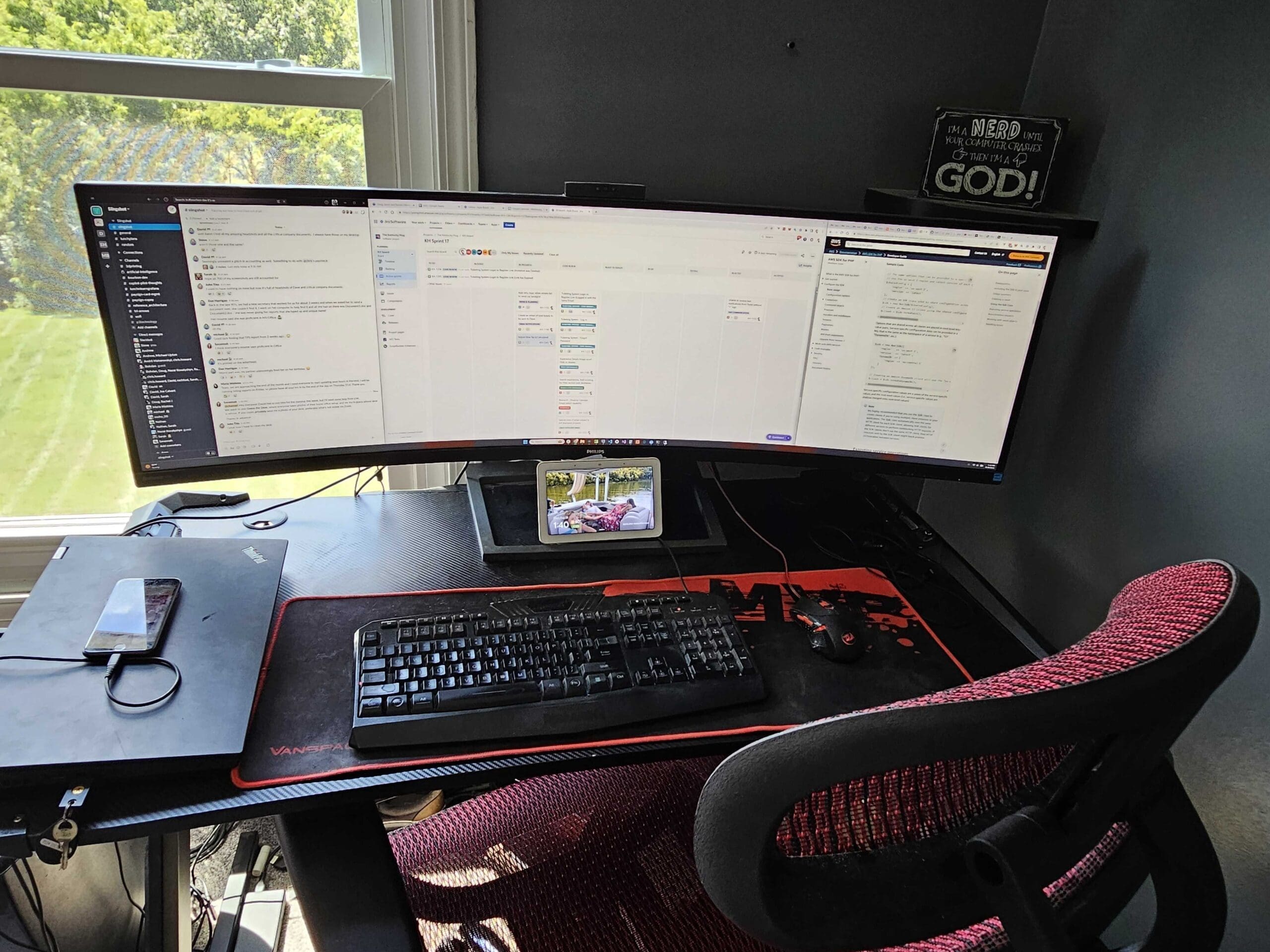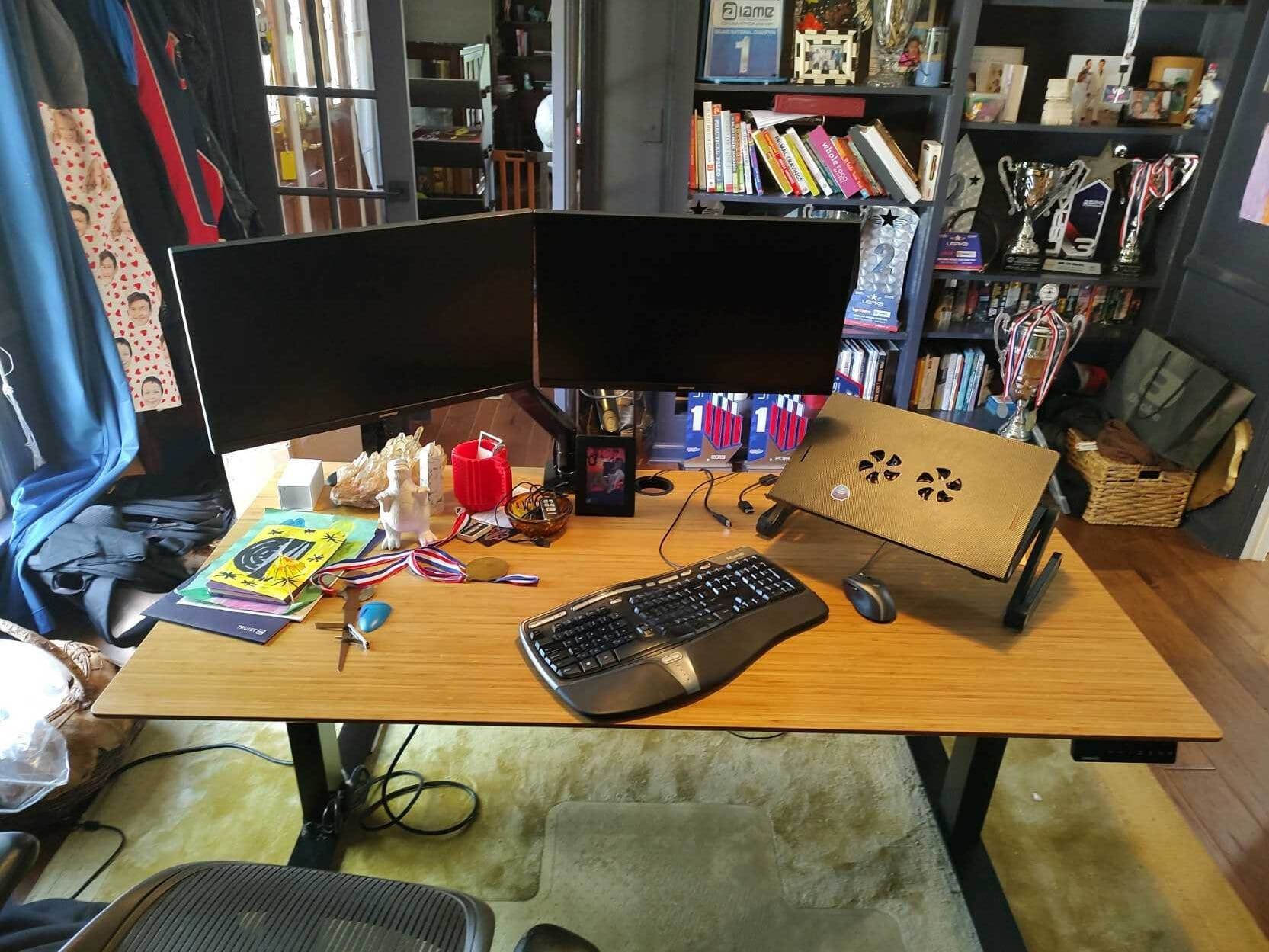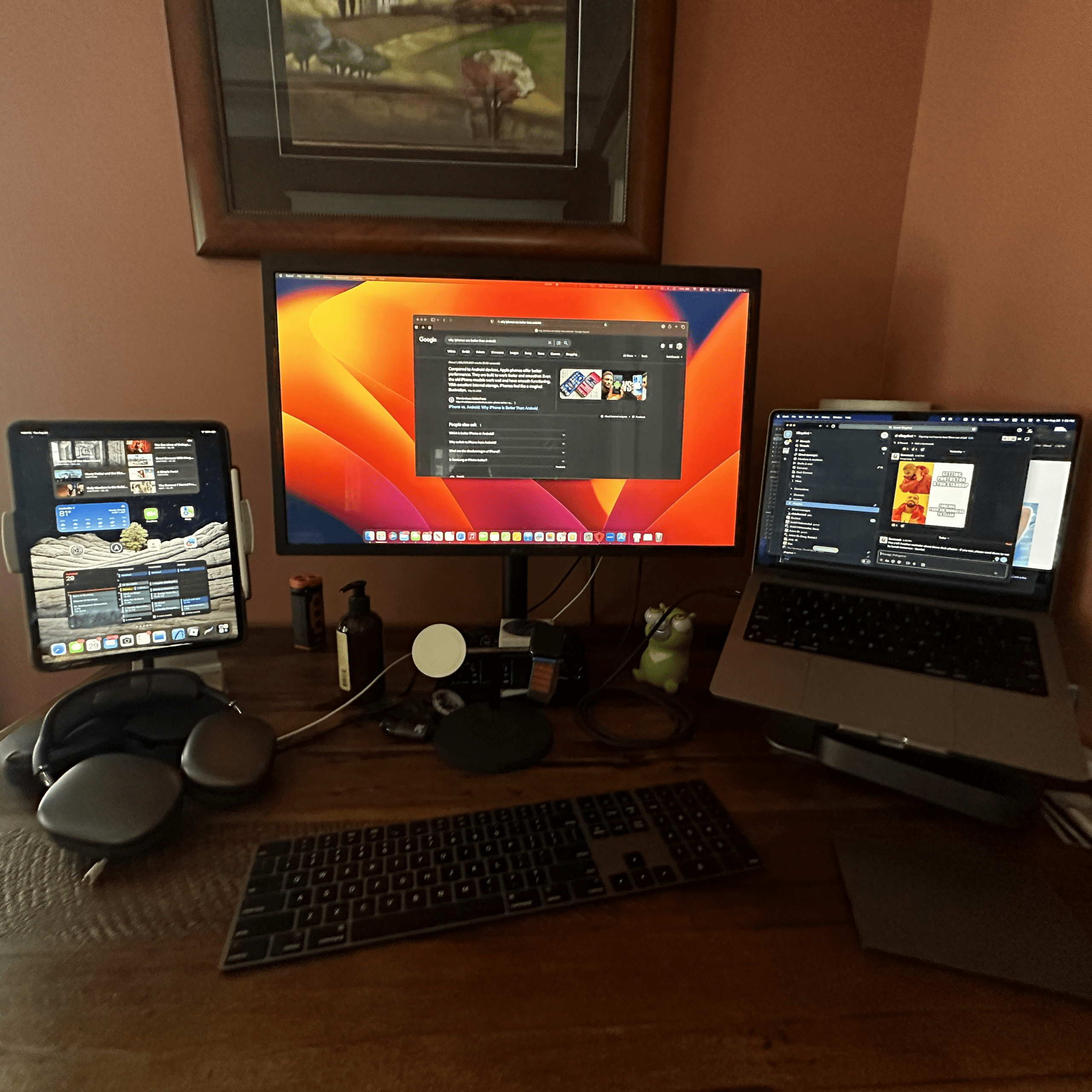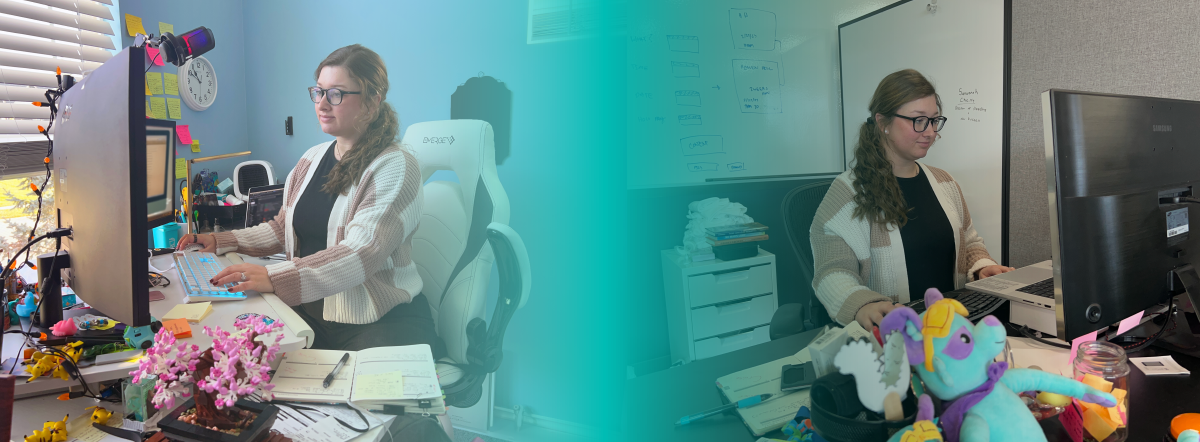Slingshot has been ahead of the game when it comes to hybrid work—offering some form of work-from-home option since 2009! While the world caught up during COVID, we’ve been fine-tuning the balance between working from home and collaborating in the office for years.
In this blog, our team shares their experiences, tips, and favorite tools for making hybrid work actually work—from comfy home setups to keeping our office vibe alive. It’s all about finding what clicks for you, and we have plenty of insights to share!
Summary
Our team shares their go-to tools, productivity hacks, and tips for staying connected and engaged, whether they’re at home or in the office. From home office setups that promote comfort and focus to strategies that prevent burnout, this blog gives you an inside look at how we make hybrid work feel effortless. Ready to learn more? Scroll down for the full story!
What’s your name and title?
Chris Howard
My name’s Chris, and I’m the CIO at Slingshot
Savannah Cherry
I’m Savannah, Director of Marketing and New Business at Slingshot
Sarah Bhatia
I’m Sarah, Principal Product Lead at Slingshot
Whitney Powell
I’m Whitney, Marketing and Sales Coordinator at Slingshot
David Galownia
Founder and CEO, David Galownia
Steve Anderson
I’m Steve Anderson, Principal Developer & AWS Architect at Slingshot
How long have you been working with a hybrid work schedule? Why did you transition to hybrid? If it was pre-COVID, how did things change in 2020?
Chris Howard
I’ve worked a hybrid schedule for about 10 years. Before joining Slingshot, my job required frequent travel, so I would work from home when I wasn’t on the road. After I joined Slingshot, I worked in the office for several years until COVID, and have since returned to a hybrid schedule. The tools required for hybrid work advanced rapidly during the COVID-19 timeframe. This is especially true with video conferencing technology.
Savannah Cherry
I’ve been on a hybrid schedule since January 2020, when I joined Slingshot. At first, we had the option to work hybrid, but I was always in the office. Then, when COVID hit in March 2020, Slingshot went fully remote like a lot of other tech companies. Since returning, my team and I have really leaned into the hybrid setup, where I work from home about 3-4 days a week and head into the office for meetings or events.
Sarah Bhatia
I’ve been on a hybrid schedule since I joined Slingshot in 2021. In previous jobs, I’ve experienced being fully remote and fully in-office. The hybrid approach is definitely the best of both worlds.
Whitney Powell
I have been on a hybrid schedule since joining the Slingshot team in October 2023. This is my first experience with this type of schedule, and I enjoy getting to WFH and seeing my team in person at least once a week for meetings and events.
David Galownia
Many of Slingshot’s employees have been working in a hybrid role for years prior to COVID. However, we’ve always had a strong in-office presence. Obviously, with COVID, we all had to get used to working almost strictly from home for a long time.
I think we’ve adapted well, but we do have to make more of an effort to promote collaboration and culture as well as adapt new tools that can mimic some in-person activities we used to do. For culture, we like to joke around on our company-wide Slack channel and also hold weekly full-staff meetings where the emphasis is quite literally fun and lighthearted games. We also do interesting events at least once a quarter.
Steve Anderson
I’ve been working on a hybrid schedule for about 14 years now. Slingshot has long supported flexible work arrangements. I’ve always been drawn to the appeal of having the ability to hole up at home for some deeply productive sessions while still having the collaborative and social outlet an office setting can provide available to me.

Savannah’s Home Desk
What does your setup look like at home? At the office?
Chris Howard
My workspace is surrounded by technology: an iPad Pro on my left, a 27” high-quality monitor in front of me, and my MacBook Pro on the right. I like to keep Slack open on the iPad to easily follow team conversations, while a notepad and pen are always within reach for quick notes. I also have a small lamp I keep on while working, preferring the natural sunlight through the windows and often turning off the room lights. I enjoy looking outside during conference calls.
My dog, Molly, is always nearby, keeping me company. For all calls, I use my AirPods Max, which do a great job of blocking out background noise. Lastly, I’ve invested in a strong home network to ensure smooth performance throughout the day. My setup at the office is very similar, same configuration and technology. The only thing missing there is the dog!
Savannah Cherry
At home, I have a dedicated office space with a standing desk, desk treadmill, double monitors, and my trusty assistant (Otis, my dog)! It’s quiet with plenty of natural light, making it great for heads-down work.
I have more in-person things like post-its, dry-erase boards, and filming equipment at the office. The office is built for collaboration; the open-floor layout leads to quick discussions and spontaneous teamwork.
Sarah Bhatia
At home, I have a dedicated office space where my husband and I each have a sit/stand desk. Our office has a ton of natural light, a fireplace, and is filled to the brim with plants and books. It’s really my favorite room in our house. I have a desk at the Slingshot office, but I come into the office for collaborative sessions and tend to stick to the conference room and common spaces.
Whitney Powell
When working from home I have a dedicated office area with my laptop, monitor, moody lighting, and music playing in the background. Sometimes I need to switch up the location, so I will move outside on lovely days to soak up some sun!
At the office, we often collaborate in the conference rooms, where I spend most of my in-person time. We have a great setup with dry-erase walls, a TV, and a lot of fun furniture!
David Galownia
At first, I had a laptop on a card table! But since at home now, I have a full stand-up desk with dual monitors and laptop docking station. This is very similar to my office setup, but I also like to work from coffee shops and other locations as the variety definitely helps keep things fresh. A lot of us come into the office once or twice a week to meet in person.
Steve Anderson
My home office is a dedicated room in our basement. I’ve got a 47” ultrawide monitor that sits on a gaming table that’s just wide enough to accommodate it. A fun RGB lit keyboard/mouse combo and a comfy chair round it out. At the office, if I’m expecting to take meetings I’ll either hijack the conference room or one of the private offices, but generally I’ll just grab an open desk in a corner somewhere.
What strategies did you and/or your team implement to effectively balance remote and in-office work? How did those strategies evolve over time?
Chris Howard
The adoption of Slack and Zoom has been key to staying connected. With much of our team located outside Louisville, we rely heavily on these tools, whether in the office or remotely. It also helps that we have a team of dedicated professionals who take pride in their work. Over time, we’ve organized several fun in-person events where team members can meet face-to-face, and small groups often gather at local coffee shops to break up the day. On top of that, the tools we use for remote engagement have come a long way. For instance, we now record most meetings, making it easy to revisit previous discussions when needed.
Savannah Cherry
From the beginning, Slack has been our primary way to chat internally, and we already had Zoom on hand. As hybrid work became the norm, these tools moved from being used now and then to becoming daily must-haves. Slack keeps us in the loop with real-time updates, while Zoom lets us have face-to-face meetings even when we’re apart. Over time, we’ve figured out how to mix synchronous and asynchronous communication to reduce meeting burnout and make the most of our hybrid workdays.
Sarah Bhatia
Slingshot has thrived in a hybrid work setup largely because our culture emphasizes autonomy. We have a strong foundation built on the belief of hiring smart people and trusting them to do their jobs. In contrast, I’ve seen companies that micromanage how and where employees work, and that approach just doesn’t align with the success needed for a hybrid environment.
Whitney Powell
Our team utilizes Slack for day-to-day communication, which is more accessible than sending emails back and forth. You can get faster responses, and all your messages and groups are in one place without constant searching. Our virtual meetings are conducted through Zoom, making it easy to hop on and off calls quickly as needed.
David Galownia
We have an unwritten rule in our culture that is simple: “We are all adults here.” We believe it’s important to hire strong people and trust them to do their jobs. With a large volume of work remotely, it’s still important however to hold in-person events as well as communicate weekly with the full team. We also rely heavily on Slack for daily communication, both for getting things done but also to have fun.

Steve’s Home Desk
Steve Anderson
Slingshot as an organization does a tremendous job of empowering and trusting its employees to work in whatever manner is best for them. There are no hard and fast rules, but from a personal stand point, when solutioning or doing discovery – really any sort of highly collaborative effort – I always enjoy using those opportunities to get together in office where we can whiteboard and of course order some lunch in. Conversely, when I have a task list and marching orders already, that is when I prefer to go full introvert and lock myself in my basement office.
How have communication and collaboration practices changed since adopting a hybrid work model? What tools or processes helped the most?
Chris Howard
There are far fewer in-person meetings now, and I don’t miss them. I save money on clothes, lunches, and spend less time commuting! For day-to-day work at Slingshot, we rely on several essential tools: Zoom for video calls, Slack for team communication, Notion for project information, Figma for design work, Jira for development, Whimsical for wireframes and workflows, and Google Workspace for everything else. These tools offer advanced collaboration features, both internally and with our clients.
Plus, most verbal and written conversations are stored and easily accessible. At project kickoffs, we can share critical discussions from the sales phase, which helps better prepare the team for smooth project execution. I feel more connected now than when we were in the office full-time. With these tools, I can engage with any person or project team, no matter where they are.
Savannah Cherry
We got a lot better at communicating. Slack is our go-to for staying connected throughout the day, and Zoom has been super important for keeping our meetings face-to-face, even from a distance. Using an online wiki like Notion has really changed the game, helping everyone stay on the same page whether they’re at home or in the office.
Sarah Bhatia
We have no shortage of tools that we use to collaborate and move through our day. From Slack and Zoom for communication to Notion and Whimsical for shared collaborative spaces, our team has utilized the tools we have to work in a hybrid environment efficiently.
Whitney Powell
My favorite tools that we use as a team are Notion and Slack. Notion makes it easy to keep everything organized and in one place. Whether it is employee documents or needing information on a specific project, everything isn’t hard to find! I prefer Slack over emailing any day. It is much easier to find conversations and messages exactly who you are looking for without searching a trail of emails.
David Galownia
Whimsical is a great tool for brainstorming, high-level thinking, and collaboration. Daily video calls and Slack are tools we use every day. Even with these tools, in-person meetings still play a huge role. We’ve found it unnecessary to have these daily, but also they can be extremely effective depending on the nature of the discussion. It also re-humanizes the work experience when you see someone in person versus a video call, so it will always be a strategy to remain face-to-face in the same room contact in some capacity.
Steve Anderson
Slingshot has always supported a hybrid model, however, COVID certainly did shift the company to lean much heavier on the remote end of the scale. Slack and video conferencing tools have certainly become far more integral in day to day operations.
What challenges (if any) did you face in managing productivity with a hybrid work approach, and how did you overcome them?
Chris Howard
My biggest challenge is spending too much time at home—you don’t want your home to start feeling like work. That’s why the location of your home office is so important. It should be a space you can easily step away from once the workday ends. While my home is often quieter than the office, it comes with its own set of distractions. When the kids are home during summer break, I tend to work from the office more. I’ve also had to invest time in training my dog to stay quiet on command. We’ve made a lot of progress, though she still goes wild when the delivery person shows up. This is when the investment in high-quality noise-cancelling headphones really pays off.
Savannah Cherry
At first I was REALLY bad at overworking myself; with the lines being blurred between work and home life, I’d start the day earlier and log off later. But I’ve learned to set boundaries for myself, like setting strict working hours and encouraging breaks. As a company, Slingshot has always prioritized trust and independence over micromanaging.
Sarah Bhatia
One of the challenges I have with remote work is the volume of multitasking – an infinite number of teammates can send messages on Slack or emails, and I can get spread thin pretty quickly. That’s where having an in-person option can be great – I can have a space to host team sessions where I can be fully present and focused to accomplish a task at hand.
Whitney Powell
Before starting at Slingshot, I had never worked on a hybrid or remote schedule before. My biggest challenge was figuring out the most efficient way to set up my day. After a month or so, I figured out the best ways to keep myself and my work organized to ensure everything was finished by the deadline.

David’s Home Desk
David Galownia
With the rise of remote work, there is definitely a tendency to send everything as a Slack message to teammates but realizing when to still use email and also keeping a clear list of todos for yourself is important. Mentally, you have to tell yourself you don’t need to respond to everything instantly and always remember your priorities. You can’t let the latest message you receive on Slack or email for that matter become your immediate concern when you are juggling multiple small and large initiatives simultaneously. Also giving yourself personal space to breath and take breaks keeps you sane and keeps your productivity high.
Steve Anderson
One of the biggest things I’ve struggled with at home was fitting a professional work environment into a home filled with 3 loud dogs, 3 loud kids and a wife trying to hold it all together! It was difficult for people to understand that while I was at home, I WAS still at work. Moving to a more remote location in the basement has helped (no one likes going up and down stairs!), but it mainly just took consistent reminders and eventually we all got settled into a routine that works for us.
On the in office side, the COVID shift to a much heavier remote working environment led to what initially felt like a loss of camaraderie and team. That was recognized by leadership fairly early and we started to do regular team building events which has helped tremendously.
In what ways has Slingshot company culture been maintained or strengthened while balancing WFH and in-office dynamics?
Chris Howard
I engage with more Slingshot team members now than ever in the office. Throughout the day, we have plenty of conversations on Slack—about projects, world events, sports, the latest tech, our families, and more. I believe we communicate better as a team than we used to, and everyone feels more accessible compared to the days when we hesitated to interrupt someone in their office. We’ve also become more globally connected. I love joining video calls with team members in Ukraine and hearing about their day. Whether in the office or on a video call, we still have fun and appreciate each other.
Savannah Cherry
Our ‘big kid and daredevil’ culture has thrived even more with hybrid work. We’ve switched up the all-hands weekly meeting to add a virtual multiplayer game. It’s a fun way to take a breather and help everyone connect better.
We’re also making sure our in-person activities really count. We try to have one each quarter, like heading to TopGolf, watching March Madness together, or doing some tie-dye at the park. The hybrid setup lets us be more flexible and inclusive, making sure we’re all balancing both personal and work stuff.
Sarah Bhatia
I really like that we have various Slack channels where non-work topics can be discussed. It feels like a modern version of ‘water cooler’ chat, and it fosters friendly relationships with colleagues worldwide.
Whitney Powell
To help everyone feel more connected outside of work, we host quarterly internal events to get the team together. Whether it’s catering an office lunch to watch basketball or celebrating our rank on the Inc. 5000 at The Champagenery, we always put to get together.
David Galownia
We have weekly fun-based meetings at Slingshot and also quarterly in person meetups with a fun vibe. We also poke fun at one another in our Slack channels and encourage fun conversations whenever they arise. Without in-person random collisions talking about non-work life it’s important for the culture to still allow for this.
Steve Anderson
A strong branding effort was launched and the entire company was pulled in to assist and really made us feel like we were a part of the process and had a voice in defining who we were as a company. Weekly stand ups & multiple company wide events through the year have done well to keep the team tight.
How has the hybrid work model impacted your well-being and work-life balance, and what steps have you taken to ensure support in both environments?
Chris Howard
I enjoy the balance I have now. I’m more productive than I used to be, saving time by not commuting, getting ready for work, or going out for lunch. Instead, I’ve replaced that time with increased productivity, exercising, and staying updated on the latest in tech. When we do meet in person, I find myself appreciating the time together even more.

Chris’ Home Desk
Savannah Cherry
The hybrid model has been awesome for my well-being. I really enjoy the flexibility of working from home—I can tailor my workday to fit my personal life while still staying productive. But having in-person days is great for strategizing as a group and staying connected with the team. To keep everything balanced, I stick to a routine that allows time for work, personal life, and breaks.
Sarah Bhatia
I can’t imagine my world without a hybrid work model. I have three young kids, and cutting out the hassle of a daily commute really gets me back hours to spend with my family. I would really struggle to maintain a work-life balance without Slingshot’s flexibility. At the same time, I value the ability to collaborate with my team in person when the need arises, and definitely breaks up the monotony of being at home all the time.
Whitney Powell
The hybrid work model has made a difference in my daily life. Being able to work from home allows me to balance my personal life and work life better. As much as I enjoy my WFH days, I look forward to collaborating with the team in person every week.
David Galownia
Having four kids, without remote work, life would be harder and less fulfilling. I get to see my family throughout the day, cook my own meals, and take care of personal issues without huge inconveniences. At Slingshot, we highly value work-life balance and working remotely allows room for everyone to take care of themselves in the best way they can.
Steve Anderson
Living 40 minutes from the office, I can’t overstate how much more I am able to fit into a day, both at the “office” and at home. Also having a meet up place to bounce ideas off people in person – not to mention just a change of scenery – is like having your cake and eating it too.
Conclusion
Hybrid work is more than a trend—it’s part of our commitment to flexibility, balance, and productivity. We’ve developed a model that allows us to make the most of both remote and in-office time, and we’re always evolving to support our team and culture. Whether it’s using the latest collaboration tools or hosting fun events, Slingshot remains focused on keeping our team connected, happy, and thriving in a hybrid world.
Want more Culture Content?

Assembled by: Savannah Cherry
Savannah is our one-woman marketing department. She posts, writes, and creates all things Slingshot. While she may not be making software for you, she does have a minor in Computer Information Systems. We’d call her the opposite of a procrastinator: she can’t rest until all her work is done. She loves playing her switch and meal-prepping.




